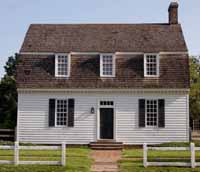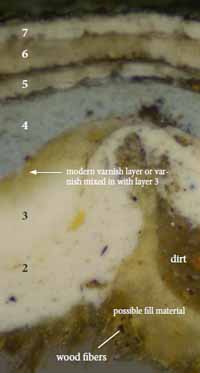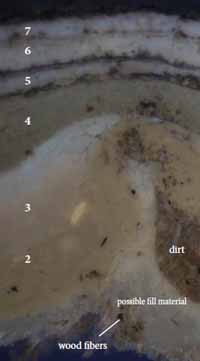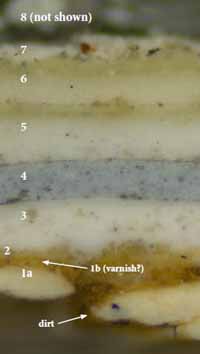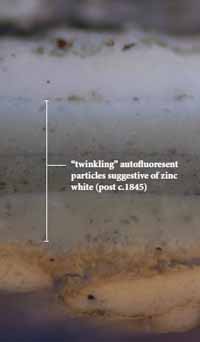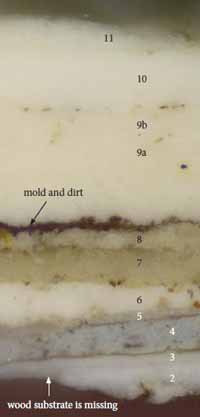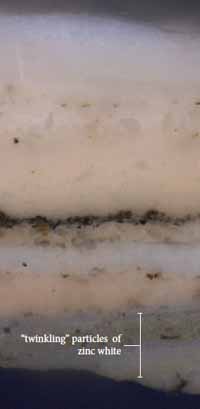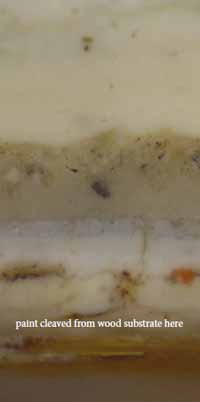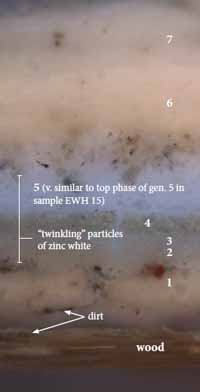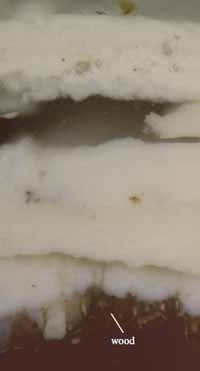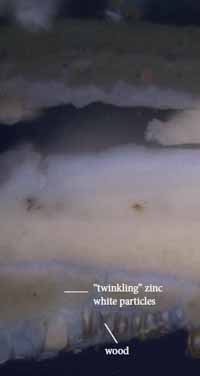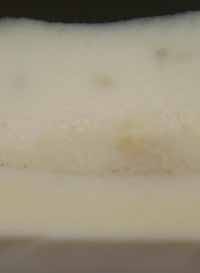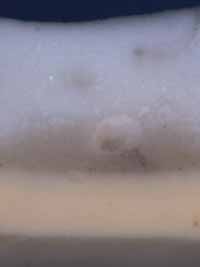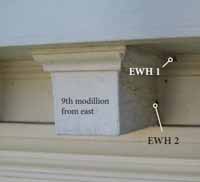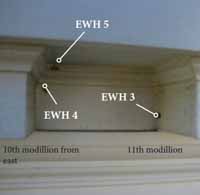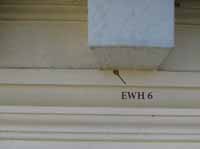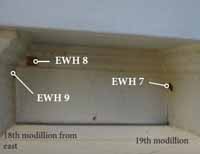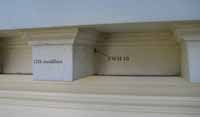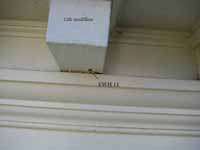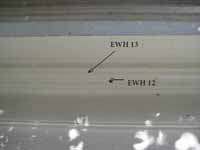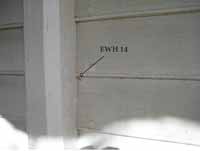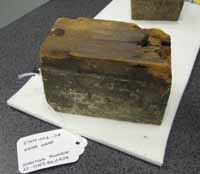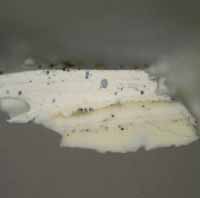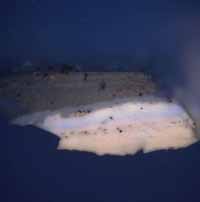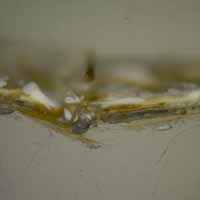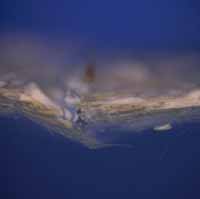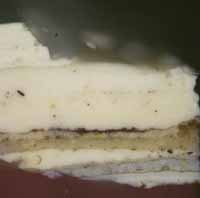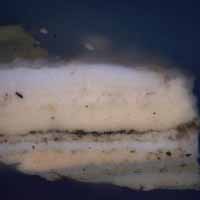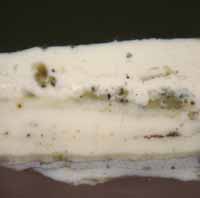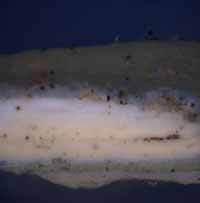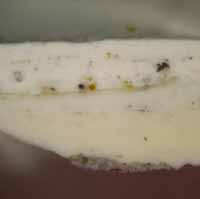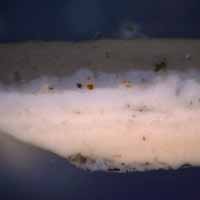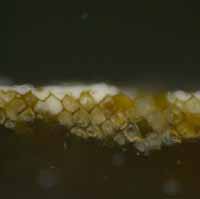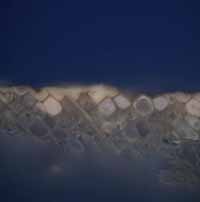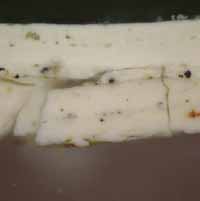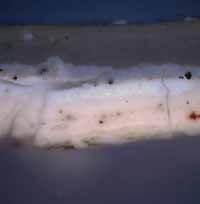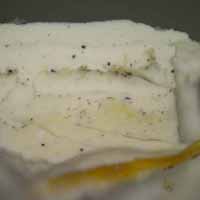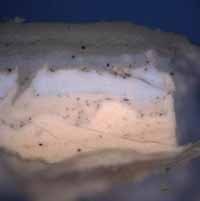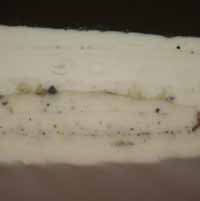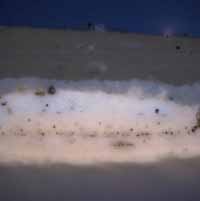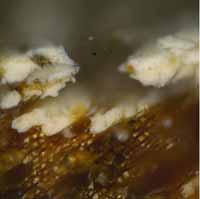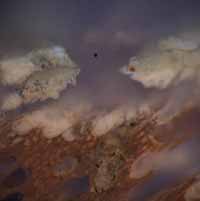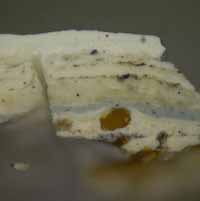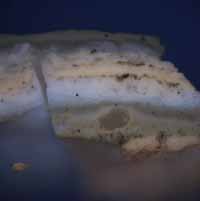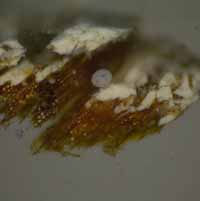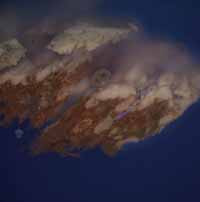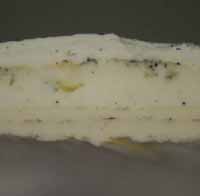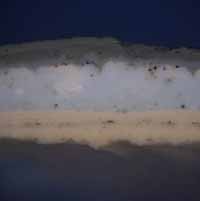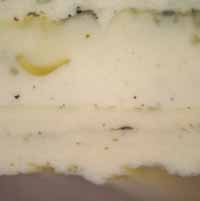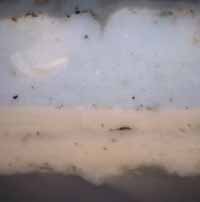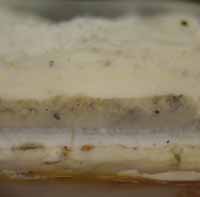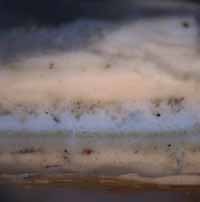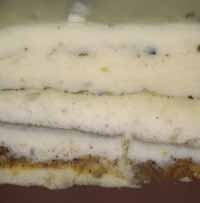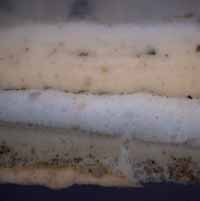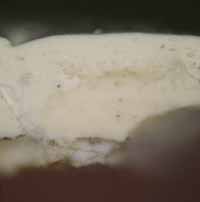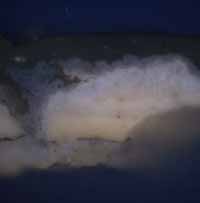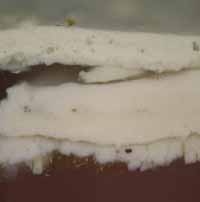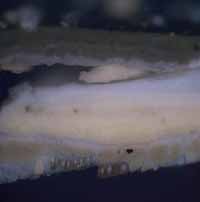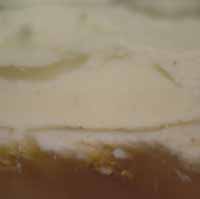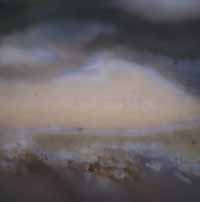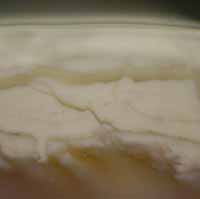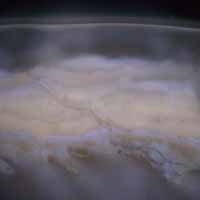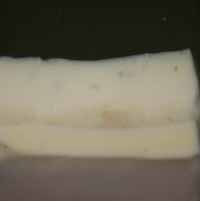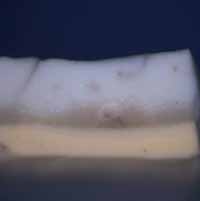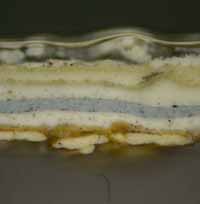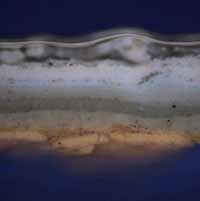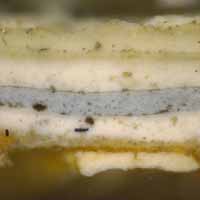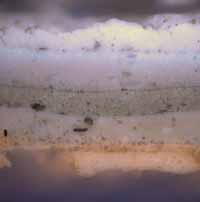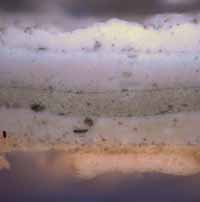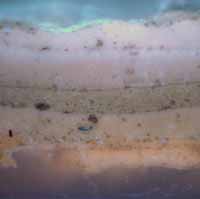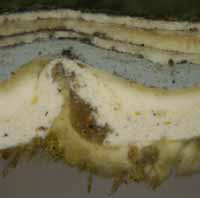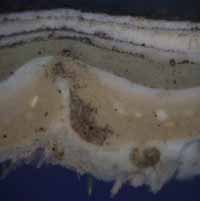Cross-section Microscopy Analysis of Exterior Paints: Ewing House (Block 2, Building 28), Williamsburg, VirginiaCross-section Microscopy Analysis Report: Ewing House, Exterior Finishes (Block 2, Building 28)
Colonial Williamsburg Foundation Library Research Report Series - 1742
Colonial Williamsburg Foundation Library
Williamsburg, Virginia
2013
CROSS-SECTION MICROSCOPY ANALYSIS REPORT
EWING HOUSE, EXTERIOR FINISHES
Block 2, Building 28
COLONIAL WILLIAMSBURG FOUNDATION
WILLIAMSBURG, VIRGINIA
| Structure: | Ewing House, Block 2, Building 28 |
|---|---|
| Requested by: | Edward Chappell, Roberts Director of Architectural and Archaeological Research, Colonial Williamsburg Foundation |
| Analyzed by: | Kirsten Travers, Graduate Fellow, Winterthur/University of Delaware Program in Art Conservation |
| Consulted: | Susan L. Buck, Ph.D., Conservator and Paint Analyst, Williamsburg, Virginia |
| Date submitted: | January 2011 |
Purpose:
The goal of this project is to use cross-section microscopy techniques to explore the early finish history of original elements on the Ewing House.
History:
The Ewing house appears on the Frenchman's map of 1782, and may have achieved its present form by 1787 (Whiffen 1984). This date is derived from construction records pertaining to the property, then owned Peter Moyer, a baker. The house still conforms to its description in an 1806 insurance policy, being "a wooden dwelling house 1 story high with dutch roof," measuring 36' x 22' (Duke 1939). Based on a central passage plan, the entrance is in the middle of the front, between two windows on the north elevation.
The house was restored in 1940. An architectural investigation carried out six years later determined that the north cornice is original with the exception of the crown molding and areas that were patched and repaired. The same study determined that only parts of the south cornice remain (Dearstyne 1950). The weatherboards, window frames, sashes, shutters, and doors have all been replaced.
Procedures:
On January 18, 2011, fourteen paint samples were removed from exterior elements by Natasha Loeblich, accompanied by Edward Chappell and Kirsten Travers. A microscalpel was used to remove samples from elements that were thought to be original to the building, specifically the north and south cornices. One sample was removed from a weatherboard for comparison. The location of sample sites was recorded and photographed, and the samples were labeled and stored in small Ziploc bags for transport. All samples were given the prefix "EWH", consistent with abbreviations already established by the architectural fragments collection at CW. A complete list of sample locations and photographs can be found in Appendix A.
3In the laboratory, samples were examined with a stereomicroscope under low power magnification (5x to 50x), to identify those that contained the most paint evidence and would therefore be the best candidates for cross-section microscopy. Uncast sample portions were retained for future examination and analysis. The best candidates were cast in resin cubes and sanded and polished to expose the cross-section surface for microscopic examination. Please see Appendix B for sample preparation details.
The cross-section samples were examined and digitally photographed in reflected visible and ultraviolet light conditions at 20x to 400x magnifications. By comparing the resulting photomicrographs, finish generations could be interpreted based on physical characteristics such as color, texture, thickness, presence of dirt layers and extent of surface deterioration. The most informative photomicrographs, their corresponding annotations, and comments from the author are contained in the body of this report.
Please note that the sample preparation, examination, and documentation was carried out by Natasha Loeblich in 2010. In December 2011, this project was handed over to Kirsten Travers who carried out historical research, additional microscopy and associated analysis, and final report writing in January 2011.
Results:
No 18th-century paint evidence was found in the samples removed from the Ewing house. Many samples, such as that from the weatherboard, contained what appeared to be only a few layers of twentieth-century paints. The modillion fragment does not contain colonial-era paints but it provided the best evidence from which other samples could be compared, and these results are discussed first. Some of the earlier paints on the cornice align with those on the fragment, but again, these do not appear to be 18th-century.
Since many samples contained redundant evidence, only the most relevant cross-section photomicrographs are presented in the following section. The paint histories pictured in each photomicrograph have been annotated according to "generation". For instance, a primer, paint layer, and varnish layer may represent one finish generation, and are all given the same number. Where applicable, the analytical results and observations are discussed adjacent to relevant photomicrographs. The results are interpreted in the conclusion, and all photomicrographs can be found at the end of this report.
EWH 16: Modillion fragment, EWH 002-08 in architectural fragments collection.
Sample EWH 16 displays a similar paint history to the other sample removed from the fragment (EWH 15, next page). Dirt embedded in the wood fibers suggests that these surfaces were exposed to the elements before painting, making it very unlikely that the existing paints date to the 18th-century. Furthermore, the first layer applied to the wood has a light brown color in visible light and a bluish autofluorescence in UV. Similar materials found throughout the Timson House at Colonial Williamsburg were analyzed with FTIR and found to contain wax, gypsum, and chalk- possible components of a wood filler used to prepare the deteriorated surface for painting (Matsen 2009). However, the accumulation of dirt on the surface of this material contradicts that theory and complicates the interpretation. Regardless, this material does not appear to date to the 18th-century.
Generation 2 is a finely-ground off-white paint (with some black and yellow particles). Its dim autofluorescence is suggestive of a modern material. Generations 3-6 are finely and consistently ground, and contain brightly autofluorescent particles that may be zinc white, a pigment not commercially available before c.1845. Generations 3-6 align with the other fragment sample (next page).
5In this sample, generation 1a is a white or off-white paint with a pinkish autofluorescence, suggestive of a lead white in oil. This paint is very degraded, but the pigments are finely and consistently ground, suggesting an industrial (post-mid-19th-century), preparation. There is a distinct layer of tannish material applied over this paint which also exhibits a pinkish autofluorescence (1b). This could be a degraded varnish applied over the first generation white paint. Although similar in visible light, this material has a very different autofluorescence from the possible fill material seen in sample EWH 16 (previous page).
Compared to sample EWH 16, generation 2 is a different coating, much thinner with a pinkish autofluorescence. However, generations 3-7 are the same. The pigments in generations 3-6 are finely and consistently ground, and contain brightly autofluorescent particles of what may be zinc white, a pigment not commercially available before c.1845. The proximity of this 19th-century layer to the substrate makes it even more unlikely that generation 1 is an 18th-century paint.
EWH 15: Fluorochrome staining results
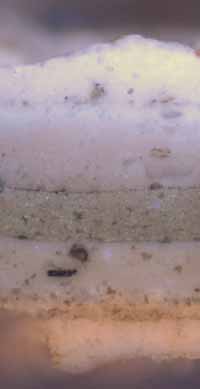 EWH 15, UV light, 200x
EWH 15, UV light, 200x
Before TSQ
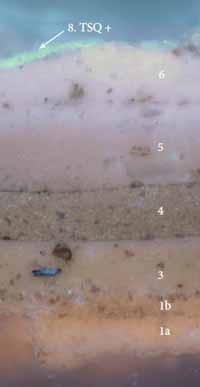 EWH 15, UV light, 200x
EWH 15, UV light, 200x
TSQ reaction
With the exception of generation 8, and possibly a very faint reaction in generation 4, no strong reactions for zinc were observed (a bright blue, "twinkling" fluorescence). Further analysis with SEM-EDS x-ray mapping could positively identify the presence or absence of zinc white.
EWH 2: North cornice, west side of 9th modillion.
Later, modern generations were cropped out of this photomicrograph to provide greater detail of the early layers (see Appendix E for complete image). Examination of the uncast sample portion confirms that while the wood substrate is missing from this sample, the complete stratigraphy is pictured here. The first three generations appear to date from the 19th-century, as they are finely and consistently ground, and contain twinkling autofluorescent particles, suggestive of zinc white (introduced c. 1845). These observations would suggest that the earliest paint history is lost here.
Generations 2-8 loosely align with the paints on the modillion fragment, but the stratigraphy that proceeds it is missing the pinkish autofluorescent generation 1.
EWH 9: North cornice, west side of 18th modillion.
Cornice samples EWH 9 (pictured here) and EWH 10 (not shown) contained stratigraphies that are very similar to those found on the modillion fragment. The stratigraphy begins with a white paint that displays a pinkish autofluorescence in UV light, suggestive of a lead white in oil. This could be the same white paint identified as generation 1 in fragment sample EWH 15. The dirt on the bottom of this paint, and embedded in the wood surface suggest that the cornice had weathered extensively prior to this paint being applied. The "twinkling" autofluorescent particles suggestive of zinc white (intro. c. 1845) in generations 2-5, make it doubtful that generation 1 is a surviving 18th-century paint.
EWH 12: South cornice, bed molding, bottom of ovolo at junction with top fillet
Both samples removed from the south cornice (EWH 12, pictured here, and EWH 13, not shown), contain similar paint histories, neither of which contain 18th-century paints. The first generation applied to the cornice is a finely-ground white paint that in UV light is seen to contain "twinkling" autofluorescent particles suggestive of zinc white (intro. c. 1845). The milky-blue autofluorescent phase or varnish at the top of this paint, (that has been absorbed into the wood substrate), is highly suggestive of a synthetic binding medium.
EWH 14: South elevation, 13th weatherboard from top.
During sampling, it was noted that the weatherboards had an accumulation of alligatored paint, but the cross-section suggests that only a few generations of twentieth-century paints are extant.
Examination at 50x magnification confirms that this is the complete stratigraphy, and the wood looks relatively new.
Conclusions
None of the samples collected from Ewing House appear to retain 18th-century paint evidence. The modillion block in the architectural fragments collection provided a benchmark for surviving paint evidence immediately proceeding the restoration (c.1939). However, the first generation of surviving paint is a finely-ground lead white paint that is not consistent with a hand-ground, 18th-century paint. Some north cornice samples have the same early paint sequence as the fragment, but dirt embedded on the bottom of the white paint and into wood surface suggests that this was not the first generation applied to the cornice.
Furthermore, the paints that immediately follow the first generation are finely-ground, display a dim autofluorescence, and appear to contain zinc white (ZnO), a pigment that was not available before c. 1845. Fluorochrome staining was not able to positively confirm the presence of zinc, but further analysis with SEM-EDS x-ray mapping would be an ideal technique to identify the presence of zinc with confidence. Regardless, the physical characteristics of these paints strongly suggest they are industrially prepared, and their proximity to the first generation supports the theory that this white paint was not applied in the 18th-century.
The south cornice and weatherboard contained only a few layers of twentieth-century paints.
Bibliography
- Duke, Francis. 1939. Ewing house archaeological report, block 2 building 28 lot 604. Unpublished report. Colonial Williamsburg Foundation.
- Kocher and Dearstyne. 1950. Architectural report: Ewing house and forge: block 2, building 28, col. lot 604. Unpublished report. Colonial Williamsburg Foundation.
- Matsen, Catherine. 2009. Analytical report for Timson house material. Unpublished report. Colonial Williamsburg Foundation, Architectural Research Department.
- Whiffen, Marcus. 1984. The eighteenth-century houses of Williamsburg. Virginia: the Colonial Williamsburg Foundation 234-236.
Appendix A. Samples and Sample Locations
| Sample number | Sample locations | Taken by/date | Samples cast | Notes |
|---|---|---|---|---|
| EWH 1 | North cornice, cymantium on fascia 1" west of 9th modillion (from east) | N. Loeblich / January 18, 2010 | EWH 1 | two samples in one resin cube |
| EWH 2 | North cornice, west side of 9th modillion, 1" above bottom, ½" out from fascia | N. Loeblich / January 18, 2010 | EWH 2 | two samples in one resin cube |
| EWH 3 | North cornice, east side of 11th modillion, ½" up from bottom, ½" out from fascia | N. Loeblich / January 18, 2010 | EWH 3 | one sample cast |
| EWH 4 | North cornice, fillet of cymantium on fascia, 1/8" west of 10th modillion | N. Loeblich / January 18, 2010 | EWH 4 | two samples in one resin cube |
| EWH 5 | North cornice, upper fillet of bed mold 1/8" below east end of 10th modillion | N. Loeblich / January 18, 2010 | EWH 5 | one sample cast |
| EWH 6 | North cornice, fascia, upper east corner (probably dates from restoration) | N. Loeblich / January 18, 2010 | EWH 6 | one sample cast |
| EWH 7 | North cornice, west side of 19th modillion, 1" down from cymantium and ¾" out from the fascia | N. Loeblich / January 18, 2010 | EWH 7 | two samples in one resin cube |
| EWH 8 | North cornice, cymantium cyma, ¾" west of 18th modillion | N. Loeblich / January 18, 2010 | EWH 8 | one sample cast |
| EWH 9 | North cornice, west side of 18th modillion, ½" below cymantium and ½" out from fascia | N. Loeblich / January 18, 2010 | EWH 9 | one sample cast |
| EWH 10 | North cornice, west side of 12th modillion, at junction with fascia ½" below cymantium | N. Loeblich / January 18, 2010 | EWH 10 | one sample cast |
| EWH 11 | North cornice, bottom of 12th modillion, ¾" out from bed mold and 1" east of west edge | N. Loeblich / January 18, 2010 | EWH 11 | one sample cast |
| EWH 12 | South cornice, bed molding, bottom of ovolo and at middle of fascia 3' west of west end, and west of western window in south wall (wood looks early, but no early paint observed with unaided eye) | N. Loeblich / January 18, 2010 | EWH 12 | one sample cast |
| EWH 13 | South cornice, bed molding, top of ovolo at junction with top fillet, 2'8" east of west end | N. Loeblich / January 18, 2010 | EWH 13 | one sample cast |
| EWH 14 | South wall, thirteenth weatherboard from top, ¼" below twelfth weatherboard, ½" east of west post on porch | N. Loeblich / January 18, 2010 | EWH 14 | one sample cast |
| EWH 15 | Detached modillion in architectural fragments collection [EWH-002-07], left side, back edge, upper corner | N. Loeblich / date unknown | EWH 15 | one sample cast |
| EWH 16 | Detached modillion in architectural fragments collection [EWH-002-07], left side front, bottom corner | N. Loeblich / date unknown | EWH 16 | one sample cast |
Appendix B: Procedures
Sample Preparation:
The samples were cast in mini-cubes of Extec Polyester Clear Resin (methyl methacrylate monomer), polymerized with the recommended amount of methyl ethyl ketone peroxide catalyst. The resin was allowed to cure for 24 hours under ambient light. After cure, the individual cubes were removed from the casting tray and sanded down using a rotary sander with grits ranging from 200 - 600 to expose the cross-section surface. The samples were then dry polished with silica-embedded Micro-mesh Inc. cloths with grits ranging from 1500 to 12,000, lending the final cross-section surface a glassy-smooth finish.
Microscopy and Documentation:
The cross-section samples were examined using a Nikon Eclipse 80i microscope equipped with an EXFO X-cite 120 fluorescence illumination system fiberoptic halogen light source. Samples were examined and photographed under visible and ultraviolet light conditions (380-330 nm), at 20 to 200x magnifications. Digital images were captured using a Spot Flex digital camera with Spot Advance (version 4.6) software. All images were recorded as 12.6 MB tiff files and stored on a hard drive in a folder titled "Ewing" on Susan Buck's laboratory computer. A separate set of images will be stored on the CWF digital database, accompanied by a digital version of the final report.
Information Provided by Visible and Ultraviolet Light Microscopy:
When examining paint cross-sections under reflected visible and ultraviolet light conditions, a number of physical characteristics can be observed to assist with the interpretation of a paint stratigraphy. These include the number and color of layers applied to a substrate, the thickness or surface texture of layers, and pigment particle size and distribution within the paint film. Relative time periods for coatings can sometimes be assigned at this stage: for instance, pre-industrial-era paints were hand ground, lending them a coarse, uneven surface texture with large pigment particles that vary in size and shape. By contrast, more "modern", industrially-prepared paints have smoother, even surfaces and machine-ground pigment particles of a consistent size and shape. Furthermore, he presence of cracks, dirt layers, or biological growth between layers can indicate presentation surfaces and/or coatings that were left exposed for an extended period of time.
Under UV light conditions, the presence and type of autofluorescence colors can distinguish sealants, clear coatings, and binding media, from darker dirt or paint layers within the stratigraphy. For instance, shellacs exhibit a distinct orange-colored autofluorescence, while natural resins (such as dammar and mastic), typically fluoresce a bright white color. Oil media tends to quench autofluorescence, while most modern, synthetic paint formulations (such as latex) exhibit no fluorescence at all. Some pigments, such as verdigris, madder, and zinc white, have distinct fluorescence characteristics, as well. UV light microscopy is critical to help distinguish otherwise identical layers often found in architectural samples- such as successive varnishes, or multiple layers of unpigmented (white) limewash.
Fluorochrome staining:
Fluorochrome stains adapted from the biological sciences were used to characterize pigments and binding media (oils, proteins, carbohydrates), in layers within the cross-section sample. The following stains were used in this analysis:
N-(-6methoxy)-8-quinoly-1-toluene sulfonamide (TSQ): 1% in ethanol was dropped onto the surface of the sample, blotted, and cover-slipped with mineral spirits. The reaction was observed in ultraviolet light. This stain tags for the presence of zinc, therefore making it an excellent marker for the pigment zinc white (ZnO), which did not become commercially available in paints until c.1835. A positive reaction is characterized by bright, sparkling bluish-white fluorescent particles in a zinc-based paint layer.
Appendix C. Sampling Memorandum
January 18, 2010
To: Natasha Loeblich
From: Ed Chappell
Subject: Ewing House: Exterior Paint Samples
This is a list of samples you took, working with Kirsten Travers and me this morning at the Ewing House. As usual, I have included your initial impressions of the samples. Our impression is that the modillions in the north cornice and the bed molding of the south cornice are early. We saw no other early exterior fabric.
- 1.North cornice, cymatium on fascia 1" west of ninth modillion, counting from the east Appears to be a light wood and limited paint layers, so it may date from the restoration.
- 2.North cornice, west side of ninth modillion, 1" above bottom, ½" out from fascia. Dark wood, more layers with white or cream as early layer, substantially weathered. Looks earlier than #1.
- 3.North cornice, east side of eleventh modillion, ½" above bottom, ½" out from fascia. Again appears to be early.
- 4.North cornice, fillet of cymatium on fascia, 1/8" west of tenth modillion
- 5.North cornice, upper fillet of bed mold 1/8" below east end of tenth modillion
- 6.North cornice, fascia, upper east corner. Probably dates from the restoration.
- 7.North cornice, west side of nineteenth modillion, 1" down from cymatium and ¾" out from the fascia
- 8.North cornice, cymatium cyma, ¾" west of eighteenth modillion
- 9.North cornice, west side of eighteenth modillion, ½" below cymatium and ½" out from fascia
- 10.North cornice, west side of twelfth modillion, at junction with fascia ½" below cymatium
- 11.North cornice, bottom of twelfth modillion ¾" out from bed mold and 1" east of west edge
- 20
- 12.South cornice, bed molding, bottom of ovolo and at middle fascia 3' west of west end, and west of western window in south wall. The wood looks early, but you saw no early paint.
- 13.South cornice, bed molding, top of ovolo at junction with top fillet, 2' 8" east of west end. Looks like sample 12.
- 14.South wall, thirteenth weatherboard from top, ¼" below twelfth weatherboard, ½" east of west post on porch. Weatherboards within the porch have alligatored paint, but they appear to date to c.1939, like other weatherboards.
E.A.C.
Appendix D. Description of Ewing House Fragments
[this page was found in N. Loeblich's file on Ewing House]
- 1.EWH-001-07: Framing Member (tenoned framing member cut on an angle with a tenon in place); 1 piece; 3" by 4" x 4/15"; written in red pencil on back from fragment "EWING." Written in pencil on paper tag attached with thumbtack: "BUILDING: Ewing."; Wood: unidentified hardwood; pit sawn (WG, 11/14/2006: pit sawn and unidentified hardwood); no paint; 18th century; good condition; part of Bostetter Collection.
- 2.EWH-002-07: Modillion Block; removed from the exterior north cornice in 1939; this fragment was originally grouped by Jeff Bostetter with 84 other fragments from the Historic Area and other eighteenth and nineteenth-century structures in Virginia (90.0404); 1 piece; 4 ¾" x 2 9/16" x 3"; Written in pencil on paper tag thumb-tacked to fragment: "USE: Modillion/North Cornice, BUILDING: Ewing"; Written in red pencil on fragment: "N. Cornice/Ewing Ho. 1939" (this text is very faded and difficult to read); Paint: dark green over white over blue-gray; Rectangular modillion block; fragment has two wrought nails protruding (one tip is visible from the top where the soffit would have been and one head visible on the side that would have attached to the fascia); some evidence of dark green paint visible on three sides; white paint is somewhat visible beneath the green paint (best seen on the bottom of the fragment) and some faint evidence of blue/gray paint; ghost mark visible where smalling [smaller] pieces of molding surrounded block on the soffit; 18th century; Fair: bottom edge near fascia has decayed (probably to the point where it was easy to remove the block without removing the nail from the fascia) and some of the top edge close to the soffit has also decayed; part of Bostetter Collection.
